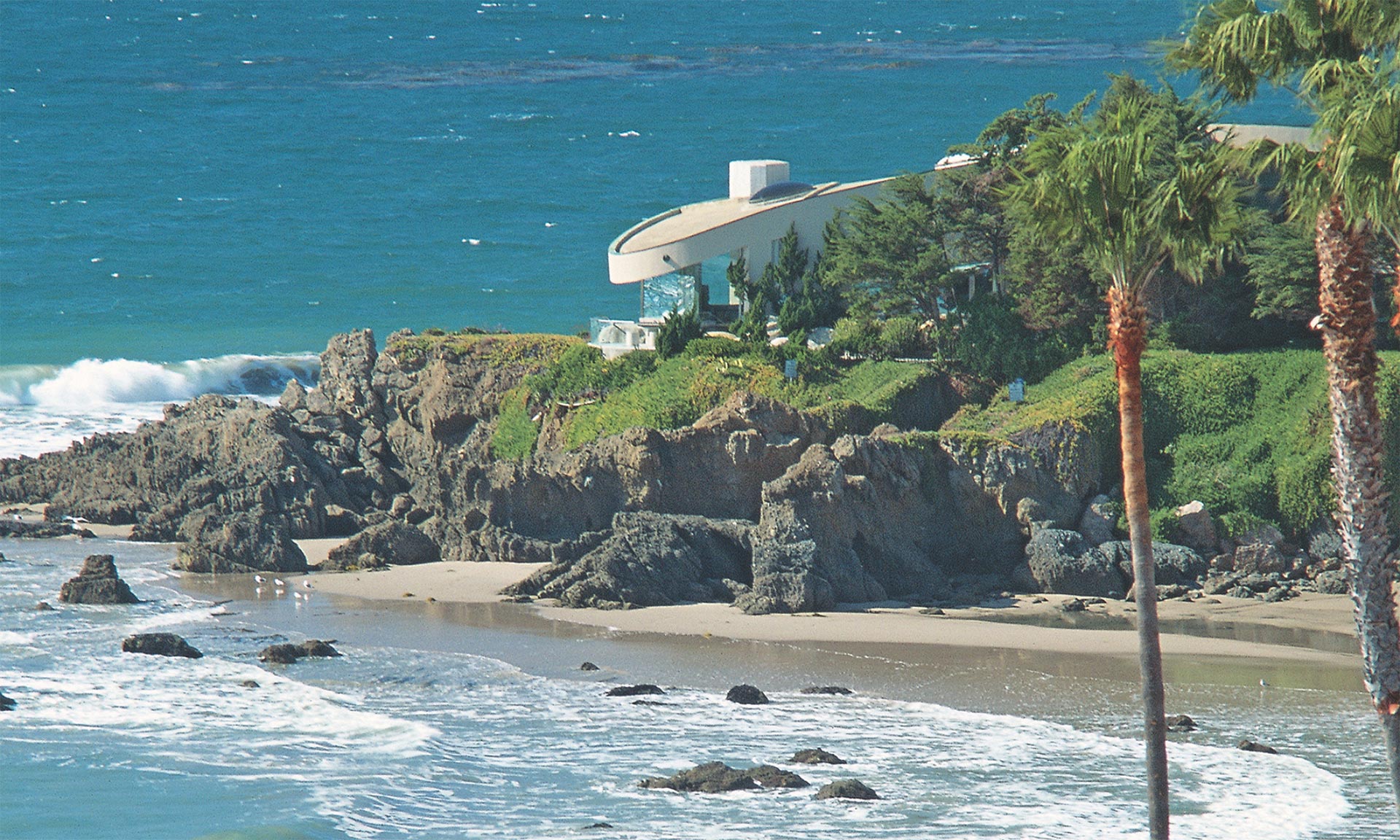
Malibu
The mythic name of this fabled, jewel-like community rolls off the tongue like Xanadu, Bali Hai, or Shangri-La: Malibu. No other strand of beachfront, cradled by both sea and mountain, conjures the same promise of pristine beach-walks and sea-washed sunsets along some of the most prized real estate in North America, with close to 20 square miles of exceptional natural beauty located within the city limits. While isolated by geography – Pacific Coast Highway is pretty much the best route—and wealth, ultra-exclusive Malibu shimmers and glows with an aura of beguiling accessibility.
It’s pointless to ignore the unicorn in the room: beach access. Celebrities from David Geffen to the Streisand-Brolins, not to mention Angelina Jolie, Ellen DeGeneres, Jennifer Aniston, Halle Berry, Charlize Theron, Goldie Hawn, John Travolta, and Courtney Cox have all called the 90263, 90264, and 90265 home. And while their toes-in-the-sand mansions are untouchable to many in terms of price, the tideline locations that send their residential properties into eight and nine figures is technically public property. Most prominent: Malibu Colony, the über-posh gated community founded in 1926, adjacent to Malibu Pier and Surfrider Beach. Like all California beaches, the sands of Malibu are technically public land below the mean high tide line. Some, like Paradise Cove beach, artfully restrict entrance by charging a parking or admission fee, since the sand and water access lie in front of a privately owned facility by the same name. But sorry, Barbra: by law, all California beaches are open to the public, whether wealthy, famous, beautiful or otherwise.
In 2017, an accessway opened to the most fought-about celebrity beach in the ‘Bu—ironically only about one mile in length — Carbon Beach, also known as Billionaire’s Beach. This accessway, located 1/3 mile east of Nobu Malibu, is officially named the Carbon Beach West Path. And the seeming contradiction of the West Coast’s most gilded coordinates being open to the public is at the riddling heart of what makes Malibu magical.
In May 2021, an article in Forbes reported the population of Malibu as approximately 16,000. Although the name conjures movie-biz glitz and glamour, the experience of living in this storied enclave is relaxed, discreet, and neighborly. Malibu remained a private community until its late incorporation as a city in 1991.
Malibu is divided into three sections: eastern, western, and central. Many of the properties that now sell in Malibu are undeveloped lots, allowing for custom-built homes within an easy walk of the legendary surf. This affords privacy as well as superb views of the ocean horizon. Some residents may prefer a home with a bit more distance from the beach, since a hillside location just off the shore may offer a bit more seclusion, as well as a more elevated, gull’s-eye-view of the iconic waves. Properties located directly on the coast or with private beach access are among the most valuable real estate in California, and among the most lusted-after spots in the world.
The indigenous Chumash or “seashell people” called this land “Hu-maliwo” meaning “where the surf sounds loudly”, and the ears of European settlers heard the last three syllables of the name as “Malibu.” Located about 30 miles west of downtown Los Angeles, signs around the city proclaim “21 miles of scenic beauty” referring to the incorporated city limits, while in fact the community informally spans more like 27 miles, from Tuna Canyon on the southeast to Point Mugu in Ventura County on the northwest.
Malibu’s array of beaches form part of international wave-runner lore: Topanga, Big Rock, Las Flores, La Costa, Surfrider, Dan Blocker, Malibu, Zuma, Broad, Point Dume, Carbon / “Billionaire’s Beach”, Westward, Escondido, Paradise Cove, Pirate’s Cove, Trancas, Matador, Encinal Bluffs, and County Line. Add to this lineup: state beaches Malibu Creek State Park, Leo Carrillo State Beach and Park, Point Mugu State Park and Robert H. Meyer Memorial State Beach, with individual beaches El Pescador, La Piedra and El Matador.
Point Dume stands out as truly cinematic, with views of the local sea lions in all of their lolling, mammalian splendor. A hike through Solstice Canyon affords views of the Polynesian-inspired wildfire-ravaged Paul Revere Williams’ Roberts Ranch House, now more often called the Williams House, which seems as though it were created for a movie set. In spite of the builder’s diligent use of fire-resistant materials and carefully designed system of fire-prevention pumps, pipes and pools, the 1982 blaze left little more standing than the four fireplaces, a bathtub, and a bomb shelter. The Santa Monica Mountains Conservancy acquired the house in 1988, making the ruins accessible to the public.
Locals enjoy the sporting life at Malibu Racquet Club, which offers pro coaching, art exhibits and wine-tastings to members only, while literally anyone can wander into the Malibu Country Mart for a psychic reading with Jane at Malibu Shaman, floaty beach fashions at All About Bell, or a late-night cocktail at Lucy’s Steakhouse. Slightly inland, the horsey set enjoys first-class equestrian lessons, riding and trails.
By the turn of the 19th century, the Chumash lands had passed through the hands of the California Missions and was purchased by Frederick Hastings Rindge, heir to his family fortune made in shipping, banking and textile miles. In 1892, Rindge purchased a 13,316-acre Spanish land grant which soon expanded to 17,000 acres, allegedly at $10 per acre. After Rindge’s death, his wife hired armed guards to patrol the property and prevent trespassing, and even managed to prevent the Southern Pacific Railroad from building on the land. For a time, a few of Malibu’s rocky clefts, notably the 300-foot red clay palisade bluffs of El Matador State Beach, were even a secret coastal landing-spot for bootleggers during Prohibition.
It’s easy to understand the fierce desire to keep this piece of Paradise safe from the intrusions of the outer world. Rindge’s widow, May, ultimately lost her epic court case against the State of California, which sought the right of way to build Pacific Coast Highway. Still, she resisted selling and leasing the land, and in 1926 created a small ceramic tile factory called Malibu Potteries. Many of the decorative tiles bearing Moorish and Arts and Crafts motifs may be seen today in fine residences and public buildings in Los Angeles and around Southern California.
That same year, May K. Rindge founded the Malibu Colony development located south of Malibu Road and PCH, west of Malibu Lagoon State Beach, east of Malibu Bluff Parks and across from the Malibu Civic Center. Rindge’s strategy was to permit Hollywood’s most glamorous luminaries to build vacation homes in the Colony as a defensive public relations wedge to prevent railway construction. Since then, local residents have successfully defeated many county-proposed developments, from offshore freeway construction, sewer line installation, and even a nuclear power plant.
Malibu burns bright as a magnet for exceptional residential design. Landmark architectural icons in the area include the Holiday House (Richard Neutra), Stevens Residence (John Lautner), Segel House/Carbon Beach House (John Lautner), Garwood Residence (John Lautner), Borman House (Frank O Gehry) and Harry Gesner’s Wave House.
For no less than three decades, Malibu resident Johnny Carson drove himself to and from his home in Malibu Colony to his NBC Tonight Show studio in Burbank. Then, as now, the commute is worth it.
Sorry we are experiencing system issues. Please try again.

